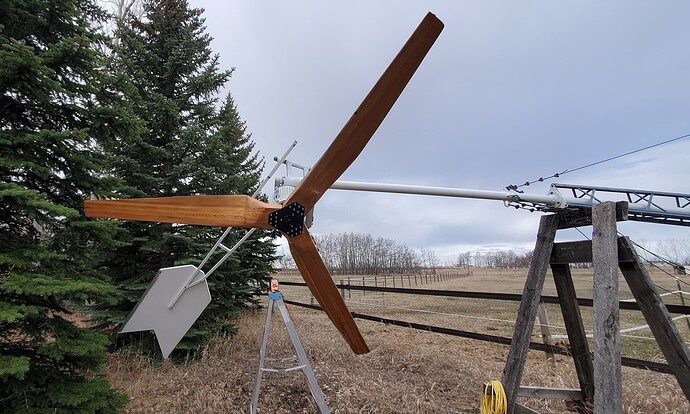This wind turbine isn’t a new project for me. Rather, it’s just another step in a series of projects I’ve done for about 20 years or so. This is what it looks like today.
I have a custom-built wind turbine which powers my little off-grid system. The hobby project has been a fun way to relax, learn, build interesting things, and satisfy an urge I have to be independent. I actually live on-grid, and it’s not something I’ll turn by back on, nor do I have a political point to make about it. Instead I use the off-grid system as a back-up because I live in the country, where the grid is expensive and unreliable. Having a alternative way to guarantee I can heat my house in the winter is important, and several times this has been essential.
This year, I intend to complete a grid-tied solar installation (Planning a PV Installation)
To make it compatible, I am making changes to the wind turbine.
The wind and PV systems won’t interact much, at first. The wind turbine will continue to recharge my battery stack, and that’s all it’s designed to do. The PV panels will generate power delivered directly to the grid. I’ve specified a particular type of inverter for the PV system that can store energy in batteries as back-up power, but the solar installer won’t do that for me. Once the grid-tie process settles down and is finished, I’ll be able to marry them up. I really look forward to doing this because this wind turbine produces way more energy than is needed to float-charge a battery bank.
To match up my batteries to the (future) grid-tied inverter, they have to be configured for 48 Volts DC. Up until now, I’ve only had the batteries wired for 24 VDC, which is typical of off-grid installations and very easy to work with. Going to 48VDC means either reconfiguring or replacing all of the equipment connected to it. The change to 48 is unavoidable because it’s the minimum that most grid-tie inverters will accept (if they are designed to work with batteries at all).
This conversion has been my project over the past couple of weeks, removing non-compatible items, and for items like charge controllers that can use multiple power supply voltages, changing their configurations to suit. The battery itself is “converted” to 48V, but actually is just jury-rigged with some heavy jumper cables where the copper bus bars used to be. This battery bank is 24 2-volt cells which, when wired in 2 parallel banks gave a 24-volt pack, and when all are wired in series the whole bank is 48V.
The wind turbine needs to run at 48VDC, too. Altering the wind turbine’s generator isn’t as complicated as it sounds, because of the way I built the generator. It’s a 3-phase motor converted to generate by mounting permanent magnets on the squirrel-cage rotor. The motor’s wiring included 12 leads, which means in 3-phase installation it can be hooked up in Star or Delta, and in Parallel or Series (and all combinations of each). Until recently I’ve been running it in Parallel-Star, which gave nice performance charging the battery bank in 24VDC for years.
In this configuration it can charge a 48V battery bank, but it will run 2x faster to do it. I actually gave that a try last week, carefully measuring what was going on to be sure there weren’t any surprises. Finding none I was technically satisfied with the performance, but I didn’t mention yet that it got VERY noisy running too fast. As expected, the noise didn’t surprise me. This weekend’s activity was to re-wire the generator into Series-Star. This 3-phase wiring configuration doubles the output voltage and effectively restores the wind turbine to its previous operating characteristics, even though I’ve doubled its operating voltage (and halved the current). Again, no surprises but I did rather wonder if there wouldn’t be at least some subtle differences. I haven’t taken a lot of measurements, just spot-checks with multimeters and a tachometer, as I went though a commissioning process.
I’m almost satisfied that the WT will work with 48. After the PV system is up and running, I’ll be moving the batteries to their new home beside the PV inverter and getting them hooked up. That will also require rerouting the buried cables from the WT tower to the garage; a little bit of trenching.
So today was a “tower” day, meaning I got up early, lowered the tower before the winds came up, did my work, and then waited for the winds to die down again before raising it back up. I got that done well before dark, so I got to do some trial runs with the system in its final configuration. The results were good, so I have finished a rather busy weekend in good shape.
The solar installers will come to assess the site in a week or so, and then hopefully I’ll be in line for an installation this summer.
